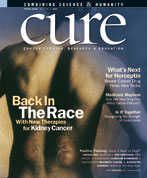Publication
Article
CURE
Web Exclusive: Q&A with Dr. Dennis Slamon
Author(s):
Dennis Slamon, MD, PhD, talks about his involvement in the history of Herceptin.
Dennis Slamon, MD, PhD, talked with CURE’s Elizabeth Whittington about his involvement in the history of Herceptin. A full transcript of their conversation follows.
Why was your HER2 research considered non-traditional at the time?
A lot of places were still using traditional approaches to treating cancer, which was to use various chemotherapeutic drugs and radiation—essentially poisons of one type or another—in the hopes of killing more bad cells than good cells. It was a one-size-fits-all approach for a lot of different cancers. All cancers within a classification essentially got the same chemotherapy regimen, but it became clear that the outcome with those regimens was very different. Some patients did very well, but many did very poorly. And once the patient had metastatic disease—meaning the disease traveled outside the primary site and beyond where the surgeon could remove it—then the patient almost always succumbed to the disease. Using chemotherapy really didn’t make an impact on survival at that point. So, a number of groups were frustrated with that and thought about backing up and beginning to study the basic science of the cells to see what converts a normal cell to a malignant cell to see if we could treat that specifically.
Why did you choose to research breast cancer and HER2?
We didn’t specifically choose breast cancer or HER2; what we specifically chose to do was look at all the major cancers. We began to study the DNA from those cancers and ask what gene or genes might be broken in them. We specifically looked at genes that would likely be regulating growth because essentially cancer is an abnormality in growth regulation of cells. In ‘84 and ‘85, the genome hadn’t been sequenced yet, so there were only a handful of genes that were really known to be bonafide genes that played a role in regulating growth control. We had banked away a lot of different types of tumor specimens and extracted the DNA, the genetic blueprint, from all those different tumors. We looked at the genes that were known at that time and looked at the DNA of all these different tumor types to see if we could find anything grossly broken using what is now pretty primitive techniques. When we got to the breast cancer specimens, we found that this gene HER2, which was a growth factor receptor, was broken in about 25 percent of breast cancers.
Once we identified that 25 percent of the women had this problem and identified that these women had a more aggressive form of the disease, the next question for the lab became why. Is it simply a flag of aggressive tumors or is it associated with bad-acting tumors because it’s playing a role in causing them. The next stage of the research was to engineer cells to have the HER2 broken. When we did that, we saw that they formed tumors more readily in mice, that the tumors were more metastatic, more aggressive—all the hallmarks of what we were seeing in the patient. When we proved that targeting HER2 using antibodies reversed the effect, we were ready to go to clinical trials. Again, the skepticism came up, that antibodies wouldn’t work because they hadn’t worked in the past. The first trials started in earnest at UCLA in ‘91-’92 where we first tested the antibody in humans. At that time, a fully human antibody had never been put in humans before, so we had to prove that it was safe. After we showed it was safe and we saw modest activity, we did a definitive trial where we compared it against the best available standard therapy and we proved it was superior.
Did you have any difficulty recruiting for the larger trials?
Initially, absolutely we did. Word was not getting out about the trials. Doctors who heard about it really did not think it was going to make a difference. Ultimately, the National Breast Cancer Coalition helped out and made a big impact by making their members aware that there was this subclass of breast cancers called HER2-positive that behaved differently than other breast cancer. The NBCC helped drive patients to look for the trial or ask their doctors about it.
How did Genentech, the eventual manufacturer of Herceptin, get involved?
Genentech was always involved from the standpoint that one of their scientists was among one of the first who cloned the gene. Our lab was the one that showed that the alteration of this gene was particularly present in these aggressive breast cancers and we told Genentech of this data. At the time, the company overall wasn’t interested, but there was a small core of scientists who felt this was interesting and worth pursuing. The precedent for antibodies was poor and a lot of the people thought this was a waste of time, but that small core within the company stuck with us and colloraborated with us through the early stages and that’s how Genentech became the company that ultimately made the drug.
Did the initial skepticism surrounding your research make your work difficult?
In some respects it made it more difficult and in some respects it made it easier. The more we saw data that told us that we were on the right track, the more convinced we became that this was the right way. I think the skepticism was from people who were looking at things more traditionally. Over the next four or five years, the observation that the women who had this alteration had a worse prognosis was confirmed from other people, and that added some credibility to our work, but at that point, many people still didn’t believe antibodies would do a whole lot because they were being tried in other tumors and they hadn’t worked. There was a bias that this would not work, and I think what people failed to recognize was that HER2 wasn’t just a marker of the tumor, it was playing a role in causing the tumor to act badly, which made it different than the other ones being tested. The skepticism also made funding difficult in the beginning, but we had a donor who believed in us in Ron Perelman from Revlon and Lilly Tartikoff from Los Angeles, who really raised money to make this program survive in the early days.
How did you get funding from Revlon?
This was before breast cancer awareness arrived on the radar screens, which happened in the early 1990s, so Perelman did this before it was popular. He did it because he and the people he worked with believed that funding HER2 research made some sense. Lilly essentially said to him, you run a company that markets products for women and makes money from women, would you consider giving something back? And it made sense to him. We told him that this was different than building a clinic or endowing a chair though, because at the end of the day, if the research ends up showing nothing, you have nothing to point to—nothing with your name on it, no building, no nice clinic with soft lights and nice carpeting and no endowed chair at a university with your name on it, just a research program that went nowhere. The flip side of the coin is if it worked, you would be impacting the lives of women not only in the place where you put this money, but potentially for women all over the world, which is ultimately what happened. Basically, without the Revlon money there wouldn’t have been a program early on.
Did you know that your presentation of the HER2 research at the 1998 ASCO (American Society of Clinical Oncology) meeting was going to have such a huge impact?
We certainly felt it would. I can’t tell you we knew because we hadn’t done the bigger trials. By then we had completed the trial comparing it to best available therapy and it showed for the first time ever we could make a survival difference in patients that had this type of tumor. That was what we always believed would happen, but once we had the proof we became even more convinced that we were right.
What are your thoughts on the recent data of Herceptin being used for early-stage breast cancer?
That’s what we hoped it would be, and in some respects, more. If we could reduce the rate of recurrence by half, that’s a pretty big impact, that’s beyond what we traditionally see. Given the follow-up data, we think it has improved cure rates. We need another year or two to be able to say that definitely, but I’m pretty sure that’s what the data is going to show.
How has Herceptin in your mind changed cancer research?
I think it validated the concept that if we identify what’s broken specifically and target it specifically, we can develop more therapies that are less toxic and more effective. That’s what the hope was and Herceptin proves that. Now we have this whole era of targeted therapies such as Gleevec, Tarceva, Sutent—all the ones you’re hearing about now.

















